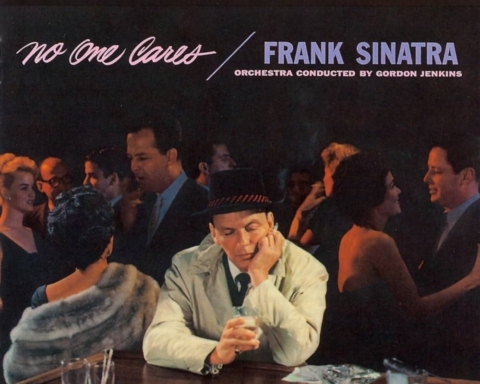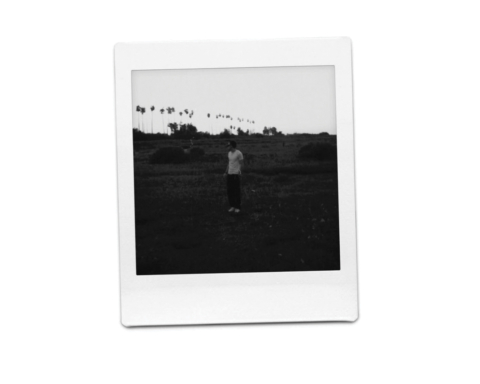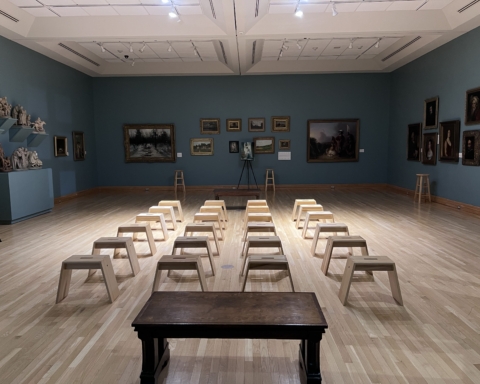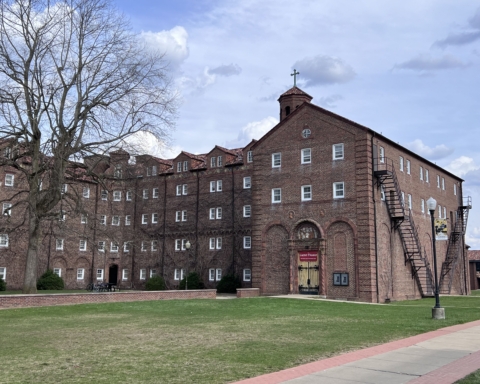On Sunday at 2 p.m., the “Out of Darkness: Putting a Face on Homelessness” talk was held at the Regina A. Quick Center for the Arts. During the talk, Gary L. Wolfe, the artist of all the displayed pieces, spoke about the journey these paintings and the models went through.
All of Wolfe’s paintings currently displayed at the Quick Center were painted using oil paints on tar paper – a gritty paper meant used when building homes. This is shown in the article photo – all black portions are exposed pieces of the underlying tar paper. This style shows the depth of oil paint on the pieces, as each stroke is shown.
To give the audience a more rich experience, Wolfe had invited three of his models Wolfe greeted the four panelists present. Three individuals, Warren, Peter and Ludine, were previously homeless individuals who were models for some of Wolfe’s pieces and later on spoke about their own homeless experiences. Karen Carmen, seated with them, worked for and ran the Matt Urban Hope Center located in Buffalo, which assists those who are chronically homeless.
The paintings explore a unique look at the lives of those who are homeless and what homelessness looks like. Their lives are different than those who have not been homeless and can be overlooked because of this.
“Sometimes it’s easy not to see the people who are right before us,” said Alice Miller Nation, director of the Franciscan Center for Social Concern.
Messages are left beside each painting in the gallery, which answer a simple question: what would you say to somebody who is not homeless? The responses the models gave ranged from blunt honesty to hopeful and uplifting.
“You know, there is such wisdom from the streets in these messages. I hope you take the time to read them,” said Wolfe.
Each of the responses were unique to the models own experiences and gives insight to how these experiences changed the model’s views on life. The models can now share this with a wide audience. It’s encouraged that the viewer reads these responses when viewing the paintings they’re with.
While going through a PowerPoint displaying various pieces, Wolfe spoke of the models backstories. Some of the models in these paintings had, unfortunately, passed away shortly after Wolfe had done their paintings. Remembering their lives and faces are important to understanding the struggles they faced and the wisdom they leave behind.
“Joanne was very excited about going to the opening. Unfortunately, she was found murdered in her apartment a month before,” said Wolfe. “This is Dean. Dean is no longer with us.”
He read Dean’s response: “Look out for people. Everybody’s supposed to help each other, you know?”
Gary asked Peter, Ludine and Warren to speak about their own experiences of homelessness and struggle, and their current living situations.
Warren told the listeners what he finally got with his own home.
“Something that I’ve always wanted, I told my mama I’d get my own porch and my own backyard,” said Warren.
Ludine, who had to leave her two children with family in another state and had other struggles, such as earning her citizenship and getting a steady income, got help from Karen’s Matt Urban Hope Center.
“I ended up getting my kids back, and I got my citizenship, all with their help. And, I got my first job,” said Ludine.
Peter, who had lived under an underpass for five years prior, was helped by the Hope Center, not only by providing him shelter, but the human connection that he had lost.
He had lost his passion and what he used to be before being homeless.
“They restored shelter, but they restored me to a connection, one that I didn’t even feel I had lost until it had been given back,” said Peter.
These are just three of many experiences. Any help is greatly appreciated, including donating to the food pantry just recently opened on campus, announced by Miller Nation. Students may make food donations to a box located in the Quick Center or by emailing Miller Nation about donating. The donations go toward helping students who may need food on campus.
The gallery will be open, for free, to any visitors until mid-November. The gallery is located on the second floor of the Quick Center in what was previously the modern art gallery.
By Catherine Fleischhut
Staff Writer
fleisccs18@bonaventure.edu







